2001 FORD TAURUS check oil
[x] Cancel search: check oilPage 5 of 256
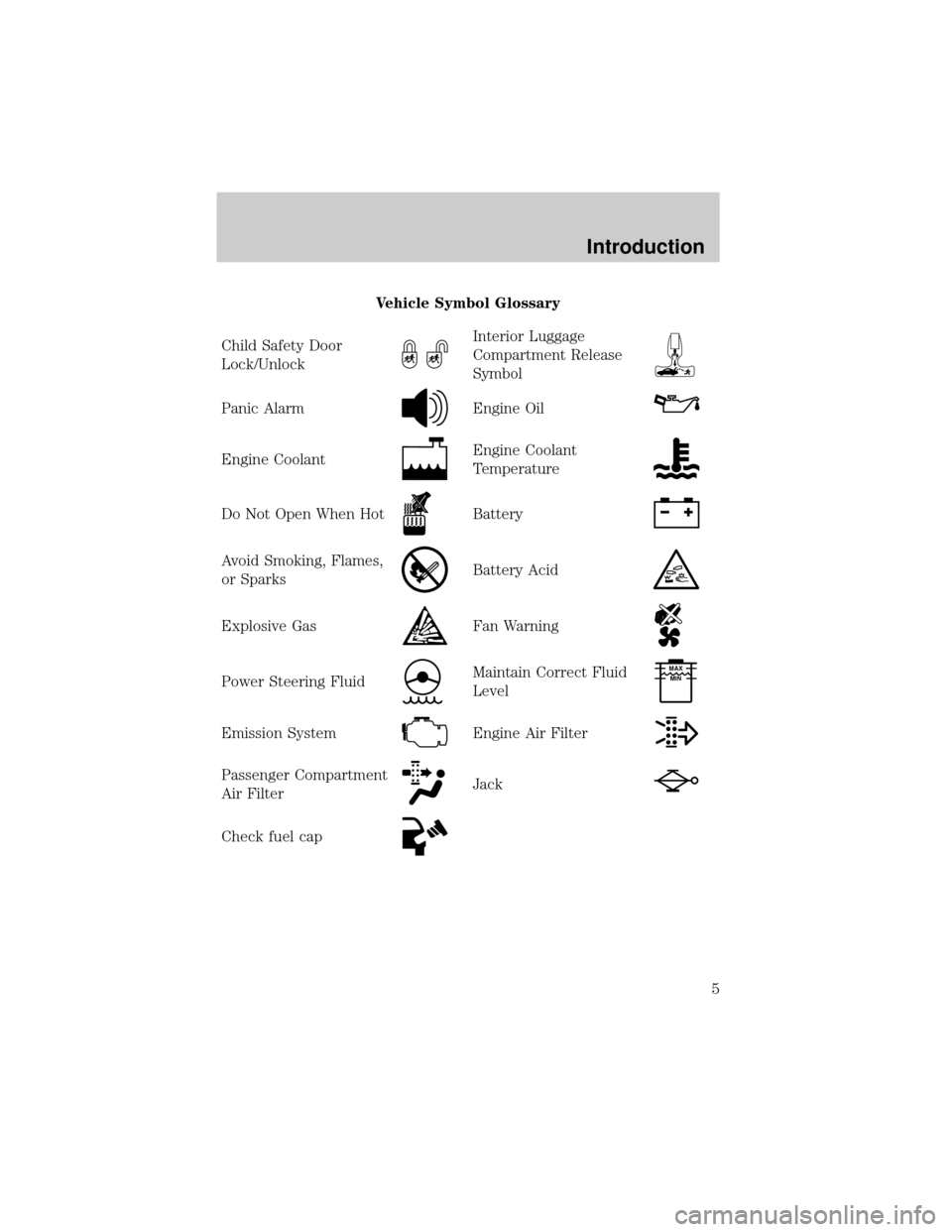
Vehicle Symbol Glossary
Child Safety Door
Lock/Unlock
Interior Luggage
Compartment Release
Symbol
Panic AlarmEngine Oil
Engine CoolantEngine Coolant
Temperature
Do Not Open When HotBattery
Avoid Smoking, Flames,
or SparksBattery Acid
Explosive GasFan Warning
Power Steering FluidMaintain Correct Fluid
LevelMAX
MIN
Emission SystemEngine Air Filter
Passenger Compartment
Air FilterJack
Check fuel cap
Introduction
5
Page 13 of 256
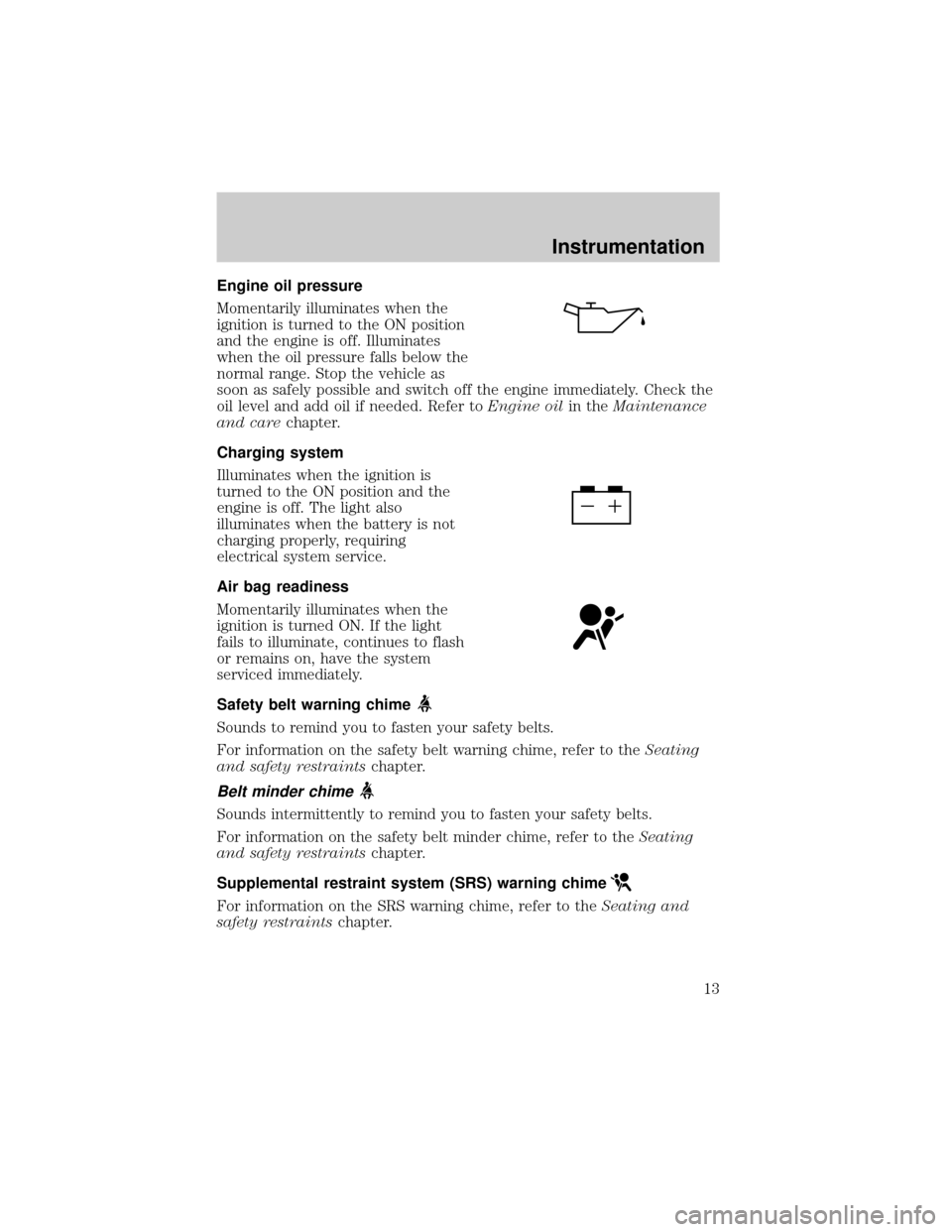
Engine oil pressure
Momentarily illuminates when the
ignition is turned to the ON position
and the engine is off. Illuminates
when the oil pressure falls below the
normal range. Stop the vehicle as
soon as safely possible and switch off the engine immediately. Check the
oil level and add oil if needed. Refer toEngine oilin theMaintenance
and carechapter.
Charging system
Illuminates when the ignition is
turned to the ON position and the
engine is off. The light also
illuminates when the battery is not
charging properly, requiring
electrical system service.
Air bag readiness
Momentarily illuminates when the
ignition is turned ON. If the light
fails to illuminate, continues to flash
or remains on, have the system
serviced immediately.
Safety belt warning chime
Sounds to remind you to fasten your safety belts.
For information on the safety belt warning chime, refer to theSeating
and safety restraintschapter.
Belt minder chime
Sounds intermittently to remind you to fasten your safety belts.
For information on the safety belt minder chime, refer to theSeating
and safety restraintschapter.
Supplemental restraint system (SRS) warning chime
For information on the SRS warning chime, refer to theSeating and
safety restraintschapter.
Instrumentation
13
Page 166 of 256
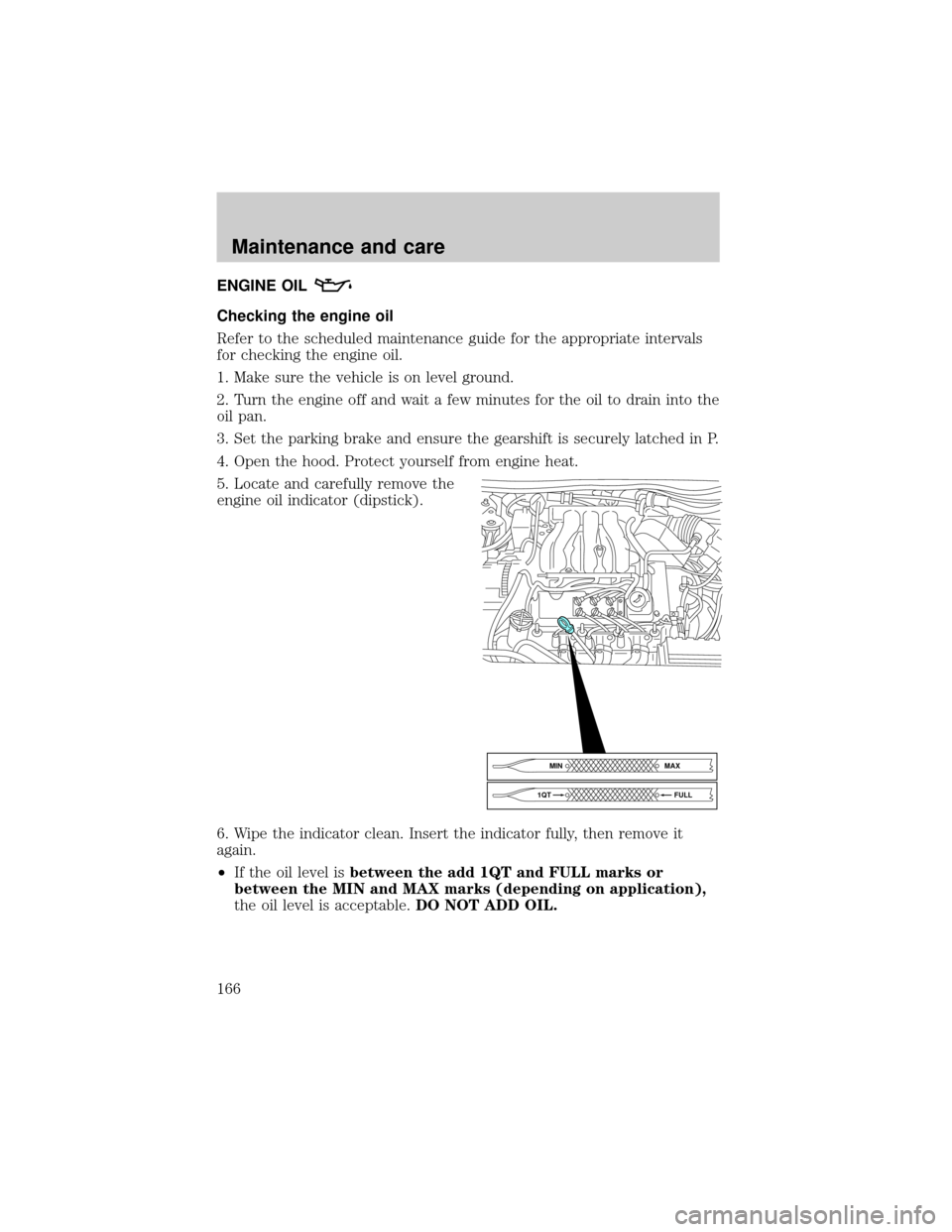
ENGINE OIL
Checking the engine oil
Refer to the scheduled maintenance guide for the appropriate intervals
for checking the engine oil.
1. Make sure the vehicle is on level ground.
2. Turn the engine off and wait a few minutes for the oil to drain into the
oil pan.
3. Set the parking brake and ensure the gearshift is securely latched in P.
4. Open the hood. Protect yourself from engine heat.
5. Locate and carefully remove the
engine oil indicator (dipstick).
6. Wipe the indicator clean. Insert the indicator fully, then remove it
again.
²If the oil level isbetween the add 1QT and FULL marks or
between the MIN and MAX marks (depending on application),
the oil level is acceptable.DO NOT ADD OIL.
MAX MIN
FULL 1QT
Maintenance and care
166
Page 167 of 256
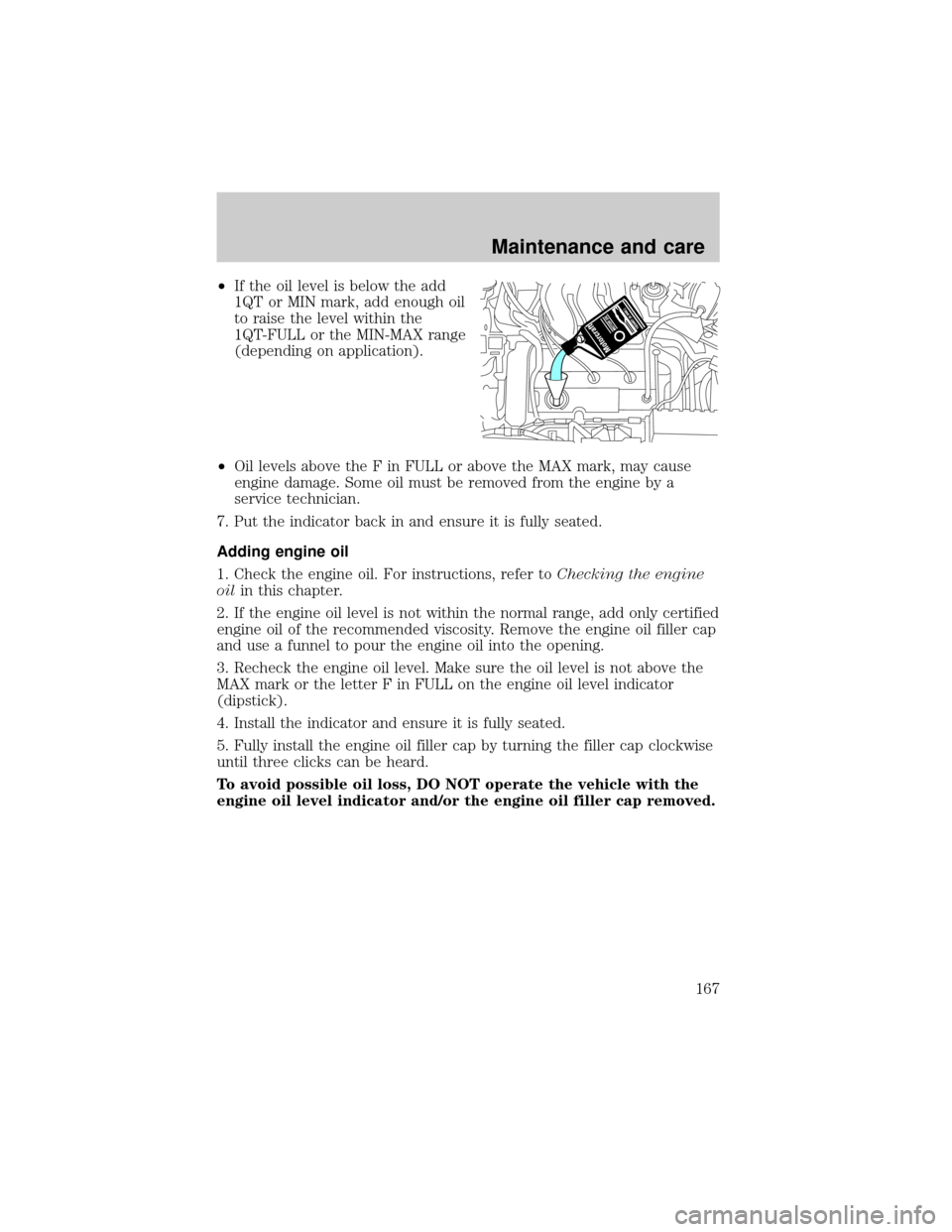
²If the oil level is below the add
1QT or MIN mark, add enough oil
to raise the level within the
1QT-FULL or the MIN-MAX range
(depending on application).
²Oil levels above the F in FULL or above the MAX mark, may cause
engine damage. Some oil must be removed from the engine by a
service technician.
7. Put the indicator back in and ensure it is fully seated.
Adding engine oil
1. Check the engine oil. For instructions, refer toChecking the engine
oilin this chapter.
2. If the engine oil level is not within the normal range, add only certified
engine oil of the recommended viscosity. Remove the engine oil filler cap
and use a funnel to pour the engine oil into the opening.
3. Recheck the engine oil level. Make sure the oil level is not above the
MAX mark or the letter F in FULL on the engine oil level indicator
(dipstick).
4. Install the indicator and ensure it is fully seated.
5. Fully install the engine oil filler cap by turning the filler cap clockwise
until three clicks can be heard.
To avoid possible oil loss, DO NOT operate the vehicle with the
engine oil level indicator and/or the engine oil filler cap removed.
Maintenance and care
167
Page 171 of 256
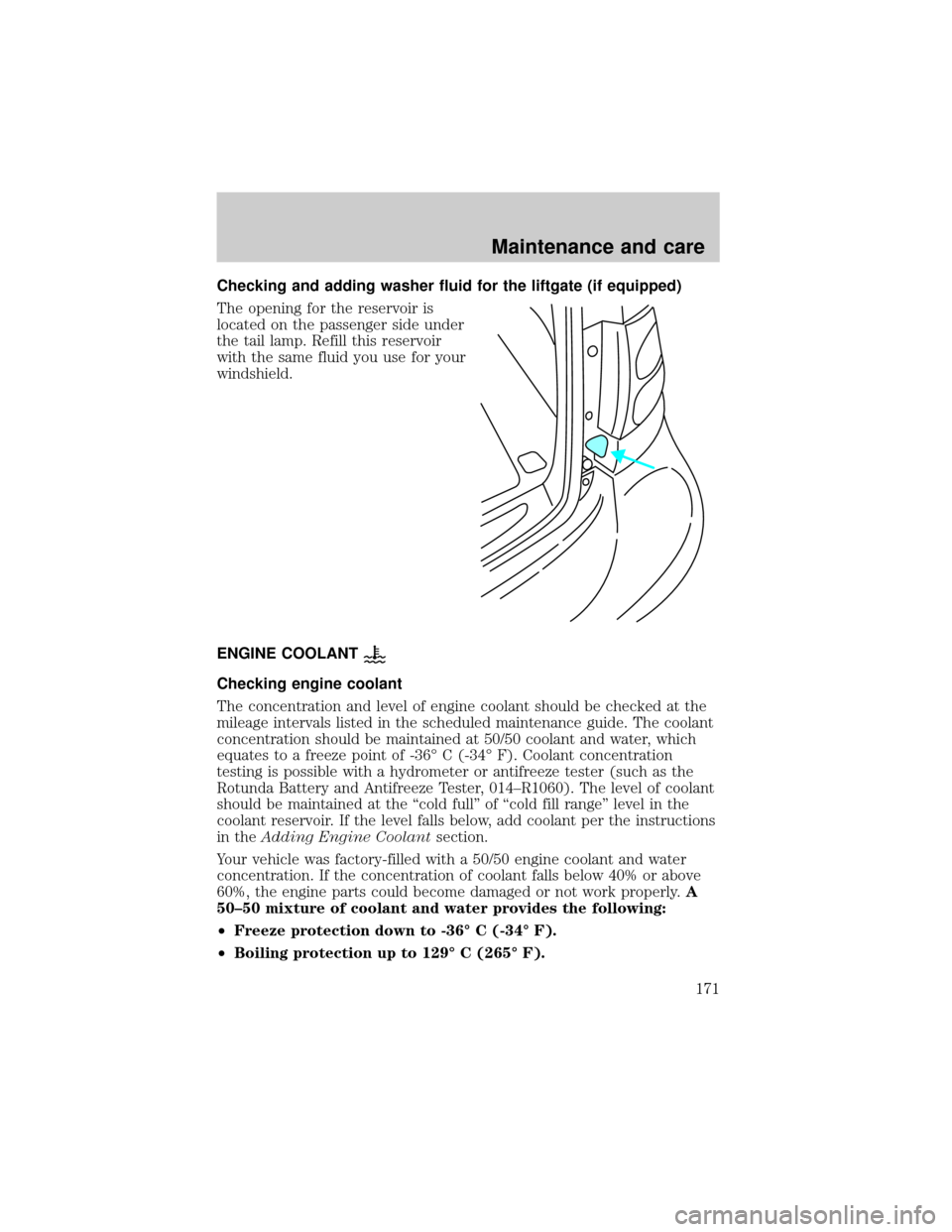
Checking and adding washer fluid for the liftgate (if equipped)
The opening for the reservoir is
located on the passenger side under
the tail lamp. Refill this reservoir
with the same fluid you use for your
windshield.
ENGINE COOLANT
Checking engine coolant
The concentration and level of engine coolant should be checked at the
mileage intervals listed in the scheduled maintenance guide. The coolant
concentration should be maintained at 50/50 coolant and water, which
equates to a freeze point of -36É C (-34É F). Coolant concentration
testing is possible with a hydrometer or antifreeze tester (such as the
Rotunda Battery and Antifreeze Tester, 014±R1060). The level of coolant
should be maintained at the ªcold fullº of ªcold fill rangeº level in the
coolant reservoir. If the level falls below, add coolant per the instructions
in theAdding Engine Coolantsection.
Your vehicle was factory-filled with a 50/50 engine coolant and water
concentration. If the concentration of coolant falls below 40% or above
60%, the engine parts could become damaged or not work properly.A
50±50 mixture of coolant and water provides the following:
²Freeze protection down to -36É C (-34É F).
²Boiling protection up to 129É C (265É F).
Maintenance and care
171
Page 221 of 256

Cleaning and maintaining the safety belts
Clean the safety belts with a mild soap solution recommended for
cleaning upholstery or carpets. Do not bleach or dye the belts, because
these actions may weaken the belt webbing.
Check the safety belt system periodically to make sure there are no
nicks, tears or cuts. If your vehicle has been involved in an accident,
refer to theSafety belt maintenancesection in theSeating and safety
restraintschapter.
Cleaning leather seats (if equipped)
To clean, simply use a soft cloth dampened with water and a mild soap.
Wipe the leather again with a damp cloth to remove soap residue. Dry
with a soft cloth. For tougher soiling concerns, Ford recommends using
the Deluxe Leather Care Kit F8AZ-19G253±AA, which is available from
your Ford Dealer. This mild cleaner and special pad, cleans the leather
and maintains its natural beauty. Follow the instructions on the cleaner
label. Regular cleaning of your leather upholstery helps maintain its
resiliency and color.
Do not use household cleaning products, alcohol solutions,
solvents or cleaners intended for rubber, vinyl or plastics.
Cleaning the interior fabric
Remove dust and loose dirt with a whisk broom or a vacuum cleaner.
Remove fresh spots immediately. Do not use household or glass cleaners.
These agents can stain and discolor the fabric. Use a mild soap and
water solution if necessary.
Maintenance and care
221
Page 244 of 256

Child safety seats ......................114
attaching with tether straps ..118
in front seat ............................115
in rear seat ......................115, 118
LATCH .....................................120
Cleaning your vehicle ...............216
engine compartment ..............218
exterior ............................216±217
exterior lamps .........................218
instrument cluster lens ..........220
instrument panel ....................220
interior .............................220±221
mirrors .....................................217
plastic parts ............................217
safety belts ..............................221
washing ....................................216
waxing .....................................216
wheels ......................................217
windows ..................................220
wiper blades ............................218
woodtone trim ........................220
Climate control (see Air
conditioning or Heating) ............19
Clock ................................33, 40, 46
Console ........................................65
Controls
power seat .................................86
Coolant
checking and adding ..............171
refill capacities ................175, 223
specifications ..................224, 226
Cruise control (see Speed
control) ........................................53
Customer Assistance ................144
Ford accessories for your
vehicle .....................................237
Ford Extended Service
Plan ..........................................230Getting assistance outside the
U.S. and Canada .....................236
Getting roadside assistance ...144
Getting the service
you need .................................230
Ordering additional owner's
literature .................................240
The Dispute Settlement
Board .......................................233
Utilizing the
Mediation/Arbitration
Program ...................................236
D
Daytime running lamps (see
Lamps) .........................................17
Defrost
rear window ..............................18
Dipstick
automatic transmission fluid .178
engine oil .................................166
Doors
door ajar warning .......................9
lubricant specifications ..........224
Driving under special
conditions
through water .........................138
E
Emergencies, roadside
jump-starting ..........................156
Emission control system ..........202
Engine ........................................226
check engine/service engine
soon light ..................................10
cleaning ...................................218
coolant .....................................171
Index
244
Page 245 of 256

idle speed control ...................185
lubrication
specifications ..................224, 226
refill capacities ........................223
service points ..................164±165
starting after a collision .........145
Engine block heater .................125
Engine oil ..................................166
checking and adding ..............166
dipstick ....................................166
filter, specifications ........168, 222
recommendations ...................168
refill capacities ........................223
specifications ..................224, 226
Exhaust fumes ..........................126
F
Flexible Fuel Vehicle (FFV) ....192
Floor mats ...................................65
Fluid capacities .........................223
Fuel ............................................192
calculating fuel economy .......199
cap .......................................9, 195
capacity ...................................223
choosing the right fuel ...........196
comparisons with EPA fuel
economy estimates .................202
detergent in fuel .....................198
filling your vehicle
with fuel ..................192, 195, 199
filter, specifications ........198, 222
fuel pump shut-off switch .....145
gauge .........................................16
improving fuel economy ........199
low fuel warning light ..............11
octane rating ...................196, 226
quality ......................................197
running out of fuel .................198safety information relating to
automotive fuels .....................192
Fuses ..................................147±148
G
Gas cap (see Fuel cap) ........9, 195
Gas mileage
(see Fuel economy) .................199
Gauges .........................................14
engine coolant temperature
gauge .........................................15
fuel gauge ..................................16
odometer ...................................16
speedometer .............................14
tachometer ................................15
trip odometer ............................16
GAWR (Gross Axle Weight
Rating) .......................................137
definition .................................137
driving with a heavy load ......137
location ....................................137
GVWR (Gross Vehicle Weight
Rating) .......................................137
calculating ...............................137
definition .................................137
driving with a heavy load ......137
location ....................................137
H
Hazard flashers .........................145
Head restraints ...........................84
Headlamps ...................................17
aiming ......................................214
autolamp system .......................18
bulb specifications ..................213
daytime running lights .............17
flash to pass ..............................17
Index
245